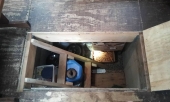












I make a Maple Syrup instructional movie! Check it out HERE
SKIP books, get 'em while they're hot!!! Skills to Inherit Property
See me in a movie building a massive wood staircase:Low Tech Lab Movie








 2
2




 1
1













A 'T' shaped fitting can provide the airflow and the protection.I have been debating whether I should use a U-turn of pipe at the top to keep rain/snow out, or the more traditional "chiminey" type cap. The concern being that a U-turn might present too much resistance to unpowered air flow.
It should be noted that many of these things require specific storage conditions that are not always compatible. For instance, I would personally never store garlic and onions or canning in the same cold slightly damp space that I would store carrots or potatoes. Garlic and Onions store extremely well in a warm dry place. While canned food can take the cold, the dampness of a cellar can cause rust on the metal lids and compromise the jar seals.you really want a cool temperature place to store lots of the things you raised in the garden during that short growing season (e.g., onions, carrots, potatoes, garlic, etc.) You want those things to last into the growing season of the following year, and a root cellar can make that happen. It is also a fabulous place to store foods canned from that short growing season--they will last for many years with no spoilage.
"Never doubt that a small group of thoughtful, committed citizens can change the world; indeed, it's the only thing that ever has."-Margaret Mead "The only thing worse than being blind, is having sight but no vision."-Helen Keller








Steve Sherman wrote:
If I can ask a question Mark, what sort of rain cap to you use on the "exhaust" vent? I have been debating whether I should use a U-turn of pipe at the top to keep rain/snow out, or the more traditional "chiminey" type cap. The concern being that a U-turn might present too much resistance to unpowered air flow.






















"Never doubt that a small group of thoughtful, committed citizens can change the world; indeed, it's the only thing that ever has."-Margaret Mead "The only thing worse than being blind, is having sight but no vision."-Helen Keller












Sometimes the answer is not to cross an old bridge, nor to burn it, but to build a better bridge.
 4
4





|
the force is strong in this tiny ad
Support permies and give beautiful gifts to gardeners: permaculture playing cards.
https://gardener-gift.com/
|





